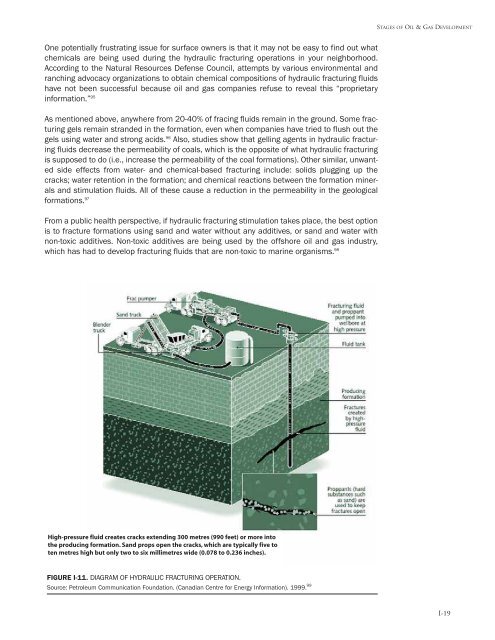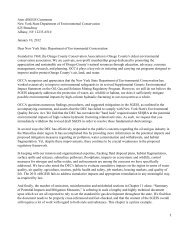Oil and Gas at Your Door? (2005 Edition) - Earthworks
Oil and Gas at Your Door? (2005 Edition) - Earthworks
Oil and Gas at Your Door? (2005 Edition) - Earthworks
Create successful ePaper yourself
Turn your PDF publications into a flip-book with our unique Google optimized e-Paper software.
STAGES OF OIL & GAS DEVELOPMENT<br />
One potentially frustr<strong>at</strong>ing issue for surface owners is th<strong>at</strong> it may not be easy to find out wh<strong>at</strong><br />
chemicals are being used during the hydraulic fracturing oper<strong>at</strong>ions in your neighborhood.<br />
According to the N<strong>at</strong>ural Resources Defense Council, <strong>at</strong>tempts by various environmental <strong>and</strong><br />
ranching advocacy organiz<strong>at</strong>ions to obtain chemical compositions of hydraulic fracturing fluids<br />
have not been successful because oil <strong>and</strong> gas companies refuse to reveal this “proprietary<br />
inform<strong>at</strong>ion.” 95<br />
As mentioned above, anywhere from 20-40% of fracing fluids remain in the ground. Some fracturing<br />
gels remain str<strong>and</strong>ed in the form<strong>at</strong>ion, even when companies have tried to flush out the<br />
gels using w<strong>at</strong>er <strong>and</strong> strong acids. 96 Also, studies show th<strong>at</strong> gelling agents in hydraulic fracturing<br />
fluids decrease the permeability of coals, which is the opposite of wh<strong>at</strong> hydraulic fracturing<br />
is supposed to do (i.e., increase the permeability of the coal form<strong>at</strong>ions). Other similar, unwanted<br />
side effects from w<strong>at</strong>er- <strong>and</strong> chemical-based fracturing include: solids plugging up the<br />
cracks; w<strong>at</strong>er retention in the form<strong>at</strong>ion; <strong>and</strong> chemical reactions between the form<strong>at</strong>ion minerals<br />
<strong>and</strong> stimul<strong>at</strong>ion fluids. All of these cause a reduction in the permeability in the geological<br />
form<strong>at</strong>ions. 97<br />
From a public health perspective, if hydraulic fracturing stimul<strong>at</strong>ion takes place, the best option<br />
is to fracture form<strong>at</strong>ions using s<strong>and</strong> <strong>and</strong> w<strong>at</strong>er without any additives, or s<strong>and</strong> <strong>and</strong> w<strong>at</strong>er with<br />
non-toxic additives. Non-toxic additives are being used by the offshore oil <strong>and</strong> gas industry,<br />
which has had to develop fracturing fluids th<strong>at</strong> are non-toxic to marine organisms. 98<br />
High-pressure fluid cre<strong>at</strong>es cracks extending 300 metres (990 feet) or more into<br />
the producing form<strong>at</strong>ion. S<strong>and</strong> props open the cracks, which are typically five to<br />
ten metres high but only two to six millimetres wide (0.078 to 0.236 inches).<br />
FIGURE I-11. DIAGRAM OF HYDRAULIC FRACTURING OPERATION.<br />
Source: Petroleum Communic<strong>at</strong>ion Found<strong>at</strong>ion. (Canadian Centre for Energy Inform<strong>at</strong>ion). 1999. 99<br />
I-19




